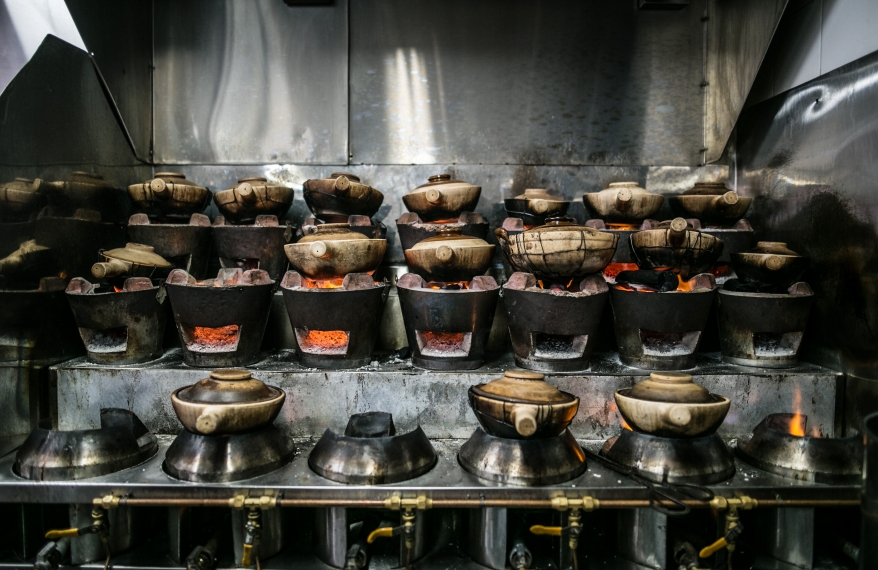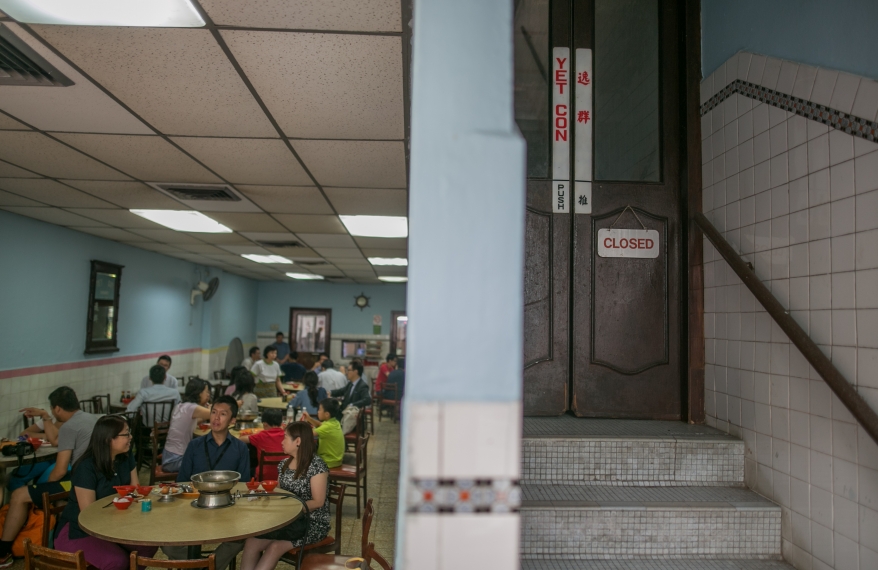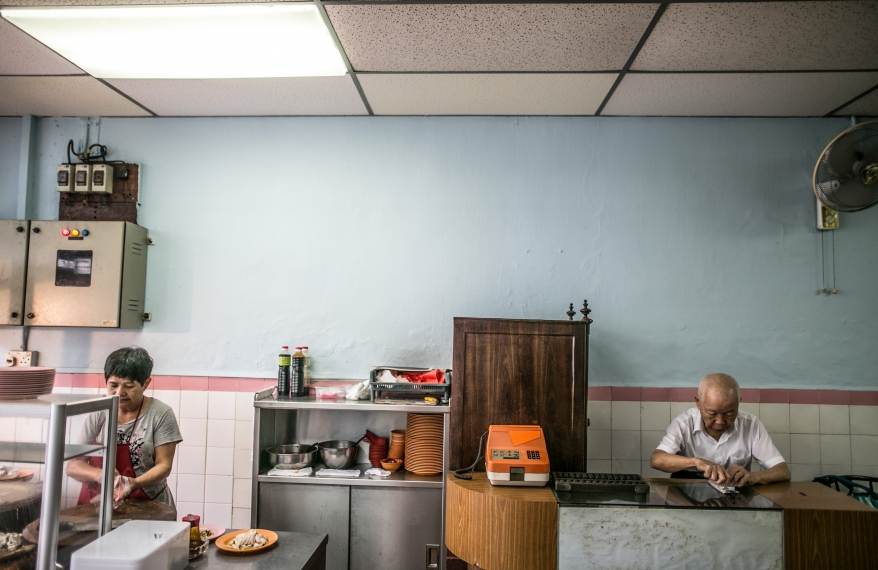With a rich multicultural heritage, this little red dot offers a wide variety of dishes that are heavily influenced by the Chinese, Malays, Indians and Eurasians. Allow us to kick-start your heritage food adventure with 10 must-try eateries!
Zam Zam
679/699 North Bridge Road, Singapore 198676
Named after a well that is located within the Masjid al-Haram in Mecca, Zam Zam sure quenches the thirst for some Malay food. It was established in 1908, and is one of the oldest restaurants that is still in the same spot as day one. The way they make their murtabak is different from other prata places. They add an extra layer of prata kosong at the base of the murtabak, break an egg over, and sprinkle minced meat on top before frying. The result? A huge and thick murtabak that is bursting with flavours. As I took a mouthful of the hearty creation, it felt like comfort food in the most sinful form. I like my murtabak with a plate of curry and a cup of teh tarik.
Lian He Ben Ji Claypot Rice
335 Smith Street, Chinatown Complex, #02-198/199, Singapore 050335
Closed on Thurs
When it comes to a satisfying one-dish meal, Lian He Ben Ji Claypot Rice is pretty hard to beat. Mdm Lim first took over the business from her father-in-law, and today juggles all 18 stoves by herself while her sisters prepare the ingredients as well as handle the orders. Here, they are sticklers for cooking time and quality ingredients. Each claypot of rice is cooked from scratch, and is first steamed over a gas stove for 5 minutes. After which, ingredients are added and the claypot is transferred to sit over a blazing charcoal flame for the next 20 minutes. When served, the aroma of steaming rice wafted through the air. Filled with juicy chicken, firm lup cheong (Chinese sausages) and silvers of salted fish, the dish could only be described as a flavour explosion. The crackle of the crispy charred rice from the base was also irresistible.
Quentin’s Eurasian Restaurant
139 Ceylon Road, Eurasian Community House, Singapore 429744
Closed on Mon
Did you know that there are four official racial groups in Singapore? Chinese, Malay, Indian and Eurasian. As the Eurasians are a minority group, there are not many places where you can still find authentic Eurasian cuisine, and Quentin is probably one of the last few in Singapore. It’s famous for the curry debal—a fiery but addictive curry made from chili, onion and blended mustard seeds, which was traditionally made from leftovers after Christmas. We tried the oxtail version and finished it off with the sugee cake, which turned out to be another must-try. Made from semolina flour and ground almonds, the old-fashioned pound cake has a lovely, crumbly texture.
Heap Seng Leong
Blk 10, North Bridge Road, #01-5109, Singapore 190010
Kaya toast served with soft-boiled eggs and traditional coffee is one of Singapore’s staple breakfasts. Heap Seng Leong is one of my regular spots whenever my foreigner friends are in Singapore for a visit. Nothing much has changed here since the 1950s. The signboard, cabinets and tiles remain the same. Even the boss himself still wears a striped pyjama bottom and white singlet to make coffee. Do order a cup of traditional kopi gu you (coffee with butter) to get a taste of the full-bodied coffee with a caramelisation that tastes similar to toffee. I like to dip my toast into the soft-boiled eggs and let the bread soak up the gooey mixture.
Heng Kee Curry Chicken Bee Hoon Mee
531A Upper Cross Street, Hong Lim Food Centre, #01-58, Singapore 510531
Closed on Sundays
One of the oldest stalls in Hong Lim Food Centre is Heng Kee Curry Mee. Even though the stall is now run by the 3rd generation Mr Tay, it is still a crowd puller with long queues forming from the start of the day. Mr Tay’s mother will first collect the orders and blanch the noodles before passing the bowl to Mr Tay, who then fills the bowl with piping hot curry gravy. Made using an over 50-year-old curry recipe, the gravy is thick and robust, with large spongy tofu puffs dancing in the bubbling pot of soup. Fronting the stall is a messy display of Hainanese-style poached chicken. But never judge the book by its cover because the meat is tender and juicy. The curry was so addictive, I just couldn’t stop till I emptied the whole bowl.
Rumah Makan Minang
18 Kandahar Street, Singapore 198884
Rumah Makan Minang offers traditional nasi padang dishes with recipes dating back to the 1950s. Of all the dishes that originated from Padang, the most famous dish is beef rendang. In Minang’s version, you’ll find chunks of beef that have been simmered in spices and coconut milk for half a day. The beef isn’t as soft as I expected, but apparently, this is how traditional beef rendang should be— chewy so that the more you bite, the more the flavours come out. The other dish that I will always order is the tauhu telor—deep fried beancurd with peanuts and bean sprouts. It is an enticing blend of spicy, sweet and savoury. The dark sweet sauce makes the dish really tasty, and the beancurd is crispy on the outside and soft on the inside.
Komala Vilas Restaurant
76 Serangoon Rd, Singapore 217981
Opened in 1947, Komala Vilas is a long-standing establishment that has become a household name in Singapore. One of their house specialties is dosai, a thin lentil crepe that typically comes stuffed with vegetable curry. The masala dosai is the most popular item on the menu here. Made with a stuffing of mildly spiced potato, it is comfort food at its best. Take your pick from the many varieties of dosai, including the plain dosai, egg dosai, onion dosai, paper dosai and many more. And the best way to enjoy your dosai? Pair it with a cup of teh halia and an idly—a steamed rice cake with a delicate fresh bread texture.
Lau Ah Tee Bak Kut Teh
Blk 34, Whampoa West, #01-67, Singapore 330034
In the 1950s, Mr Ng Mui Song started selling peppery pork-based broth to the Chinese migrants to boost their energy, and Ng Ah Sio Bak Kut Teh was started. Subsequently, the business grew bigger and Mr Ng hired Mr Sim Choon Lian, who is now the owner of Lau Ah Tee Bak Kut Teh. After the elder Ng passed on, Mr Sim left to open Lau Ah Tee Bak Kut Teh in Boon Keng. The pork ribs are from Indonesia, and are cooked only in water, with quality Sarawak peppercorns and garlic. When concocted with the right proportions and cooking time, you get a bowl of full-bodied soup with subtle sweetness from the pork ribs and robust flavours from the garlic. Lau Ah Tee also serves Teochew classic dishes such as steamed fish and squid.
Allauddin’s Briyani
Blk 665, Buffalo Road, Tekka Food Centre, #01-232/239, Singapore 210665
Allauddin’s Briyani has been around for more than four decades, and is one of my favourite spots for nasi briyani. When an order is made, they will first scoop the basmati rice from their large aluminium pot on to a plate, followed by the meat, then finish with the rice again on top to cover the meat. The result is beautiful—light, fluffy and redolent with spices such as cinnamon, cumin seed, cardamom, ground turmeric among many others. We had a choice of chicken, mutton or fish briyani, and we settled on the chicken which comes as a whole tender thigh flavourful with masala spices. Arrive early as Allauddin is an incredibly popular lunchtime spot.
Yet Con
[Permanently closed]
Purvis Street is where you used to be able to find a concentration of Hainanese coffee shops and eateries. Today, Yet Con still remains, having served traditional Hainanese chicken rice at the exact same spot since 1940. Entering the restaurant, I feel like I am transported back to the past, with marble table tops, wooden chairs, an old school abacus and orange public phone occupying the dining area. Here, the chicken is cooked the traditional way. They do not immerse the cooked chicken in cold water. Instead, they place it in trays to prevent the juices from dripping so as to retain the flavours. With some light soy sauce, you can truly get the natural taste of the meat coming through every bite. The aromatic rice comes with a lovely scent of ginger, shallots and chicken stock. They also serve Hainanese steamboat which uses clear chicken stock as the soup base, and is paired with a selection of meat, seafood and vegetables.
Enjoy a Staycation in Orchard Road at Concorde Hotel Singapore
Visit Hotel Website




























